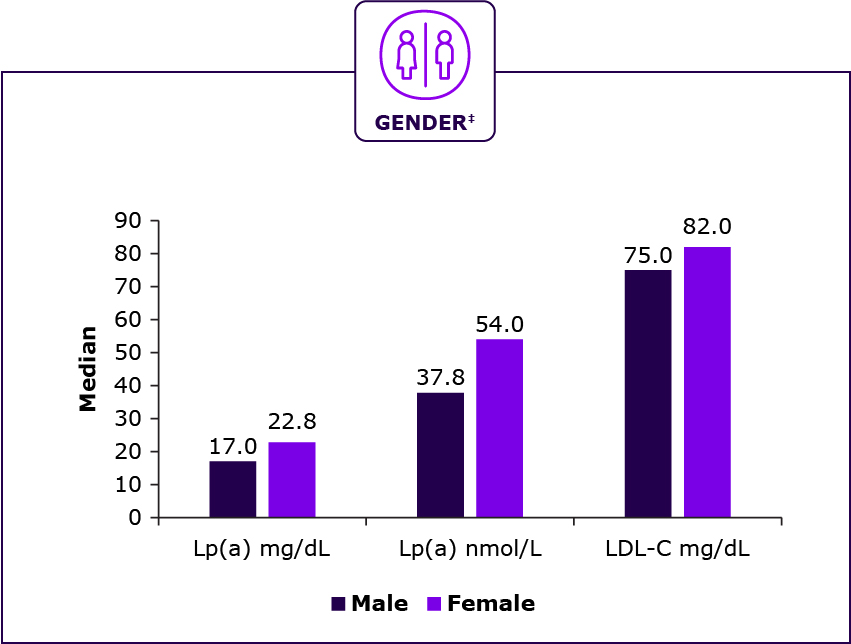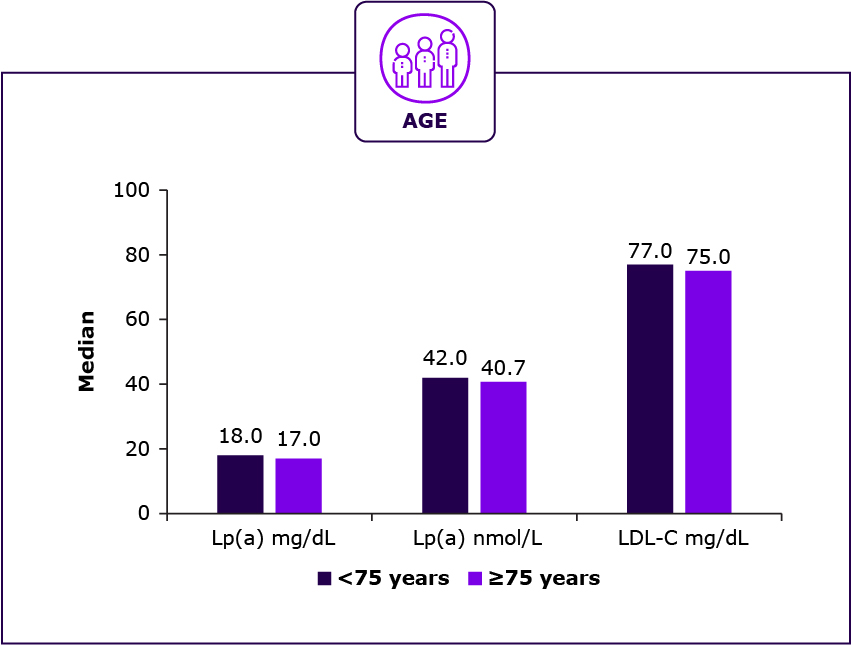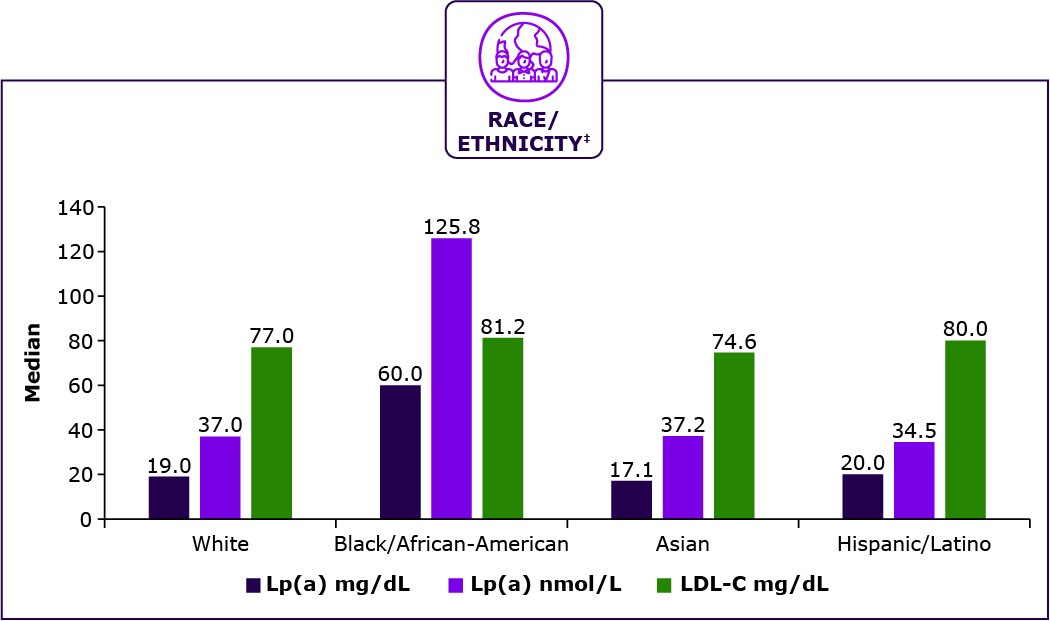Levels of lipoprotein(a) (Lp[a]) in the management of patients with atherosclerotic cardiovascular disease (ASCVD) in a global population

Key Takeaway
Lp(a)HERITAGE, the first, large, multicenter cross-sectional epidemiological study reporting the prevalence of elevated Lp(a) levels in patients with a history of ASCVD (N = 48,135), identified racial, ethnic, regional, and gender differences in Lp(a) levels, and demonstrated that:
- Most patients are presently managed without knowledge of Lp(a) levels
- Small population of patients with ASCVD were considered for Lp(a) measurements and its level was higher in young (18−54 years), female, and black patients
- Women and younger patients also showed higher levels of LDL-C; higher median LDL-C levels corelated with increasing Lp(a) levels
- >25% patients had Lp(a) levels above the range that was considered to elevate CV (approximately 50 mg/dL*)
- Elevated Lp(a) levels were observed in one fourth of the global population with ASCVD and 10% of the population showed levels >100 mg/dL
Why This Matters
- Lp(a) an important genetically determined risk factor of ASCVD. However, it is not frequently measured in clinical practice for managing patients with ASCVD.
- Presently, studies on Lp(a) measurements are available in high-income countries thus, resulting in limited data availability for comprehensive population.
- This Lp(a) HERITAGE study reported global predominance of elevated Lp(a) levels in patients with ASCVD and identified racial, ethnic, regional and gender differences, along with analyzing the correlation with LDL-C levels.

Study Design
Multicenter, cross-sectional, epidemiological study, (between April 2019−July 2021 at 949 sites in 48 countries)
INCLUSION CRITERIA
- History of MI or IS ≥3 months and ≤10 years prior to the initial study visit or symptomatic PAD
EXCLUSION CRITERIA
- Patients enrolled in clinical studies with investigational drugs
ASSESSMENTS
- LDL-C and Lp(a) measurements†: LDL-C values obtained ≤1 year before study visit and Lp(a) tested ≤5 years before study visit were accepted
Key Results
48,992 patients were screened and of these 48,135 eligible patients were included in the study, 13.9% had prior measurements of Lp(a) (Mean age = 62.6 years; Females = 25.9%)
LEVELS OF Lp(a) AND LDL-C



RELATIONSHIP BETWEEN Lp(a) LEVELS, LDL-C MEASUREMENTS AND AGE
| Median LDL-C levels were constantly higher with increasing Lp(a) levels (P <0.001 for trend) | |
| For Lp(a) level ≥150 mg/dL | Median LDL-C = 85.1 mg/dLg |
| For Lp(a) level <10 mg/dL | Median LDL-C = 75.0 mg/dL |
| Younger patients had higher Lp(a) levels than older patients (P <0.001) | |
| Age group 18−54 years | Median Lp(a) = 19.7 mg/dL |
| Age group 72−90 years | Median Lp(a) = 17.0 mg/dL |
| Lp(a) levels mg/dL | Proportion of patients (%) |
| ≥50 | 27.9 |
| ≥70 | 20.7 |
| ≥90 | 12.9 |
| ≥100 | 10.4 |
| 26.0% patients exceeded 150 nmol/L with levels above the threshold for CV risk | |
Lp(a) LEVELS BY ATHEROSCLEROTIC DISEASE HISTORY AND BY GEOGRAPHIC REGION
| History of CV disease | Patients (%) | Lp(a) (mg/dL) |
| MI | 72.9% | 18.2 |
| IS | 12.5% | 14.0 |
| PAD | 9.2% | 21.0 |
- Lp(a) levels were similar in most regions except North America with highest levels (median: 48.0 mg/dL) vs all other regions combined, P <0.001. Median (IQR) LDL-C value (mg/dL) vs other regions was:
- Lowest in North America (69.2 [53.0−93.0])
- Highest in Eastern Europe (88.2 [68.1−117.9]) (P <0.001 for both)
ABBREVIATIONS:
CV, cardiovascular; IQR, inter quartile range; IS, ischemic stroke; LDL-C, low-density lipoprotein cholesterol; Lp(a), lipoprotein a; MI, myocardial infarction; PAD, peripheral artery disease.
Limitations
- Descriptive† study design and unreliable statistical comparisons between subgroups
- Use of local laboratory values and different methods for Lp(a) measurement
- Use of historical data for Lp(a) and LDL-C (introducing referral bias)
- Use of both mass and molar concentration units (preventing uniform comparison of subgroups of interest)
For additional information, please refer the source publication Nissen SE, et al.
* 50 mg/dL or 125 nmol/L
† P values should be interpreted as exploratory (purely descriptive study, no randomized comparator group)
‡ P <0.001 for gender and race/ethnicity comparison
ABBREVIATIONS:
ASCVD, atherosclerotic cardiovascular disease; CV, cardiovascular; IS, ischemic stroke; LDL-C, low-density lipoprotein cholesterol; Lp(a), lipoprotein a; MI, myocardial infarction; PAD, peripheral artery disease.
Nissen SE, Wolski K, Cho L, Nicholls SJ, Kastelein J, Leitersdorf E, et al. Lipoprotein(a) levels in a global population with established atherosclerotic cardiovascular disease. Open Heart. 2022;9(2):e002060. doi: 10.1136/openhrt-2022-002060. PMID: 36252994.
MAT-KW-2300053/V1/FEB2023